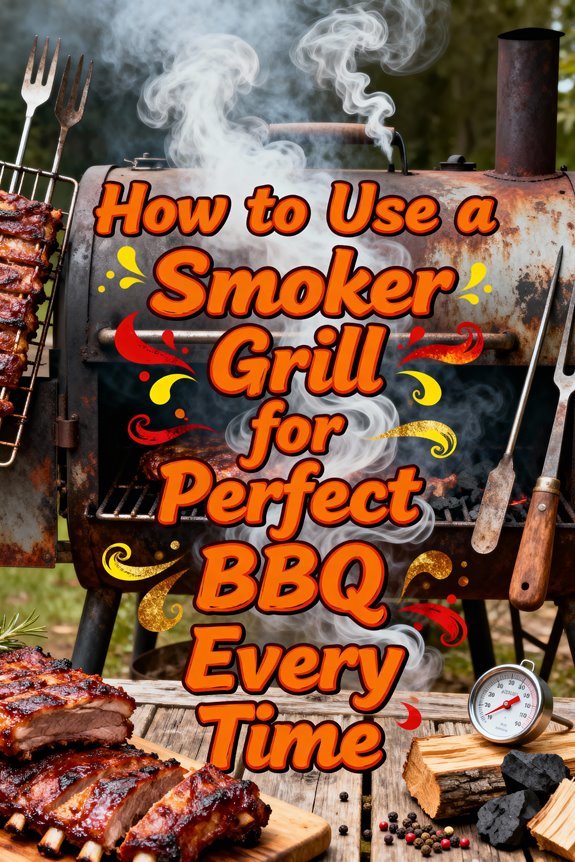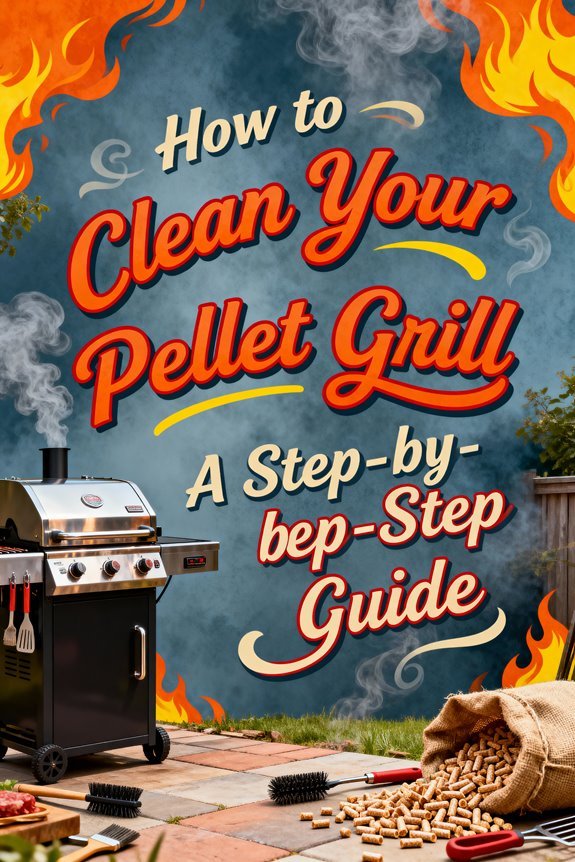Start by preheating your smoker to 225-275°F using quality charcoal and seasoned hardwood for clean, thin blue smoke. Trim your meat, apply rub generously, and let it rest at room temperature for an hour. Place a water pan above the heat source, position meat away from direct flames, and monitor internal temperature with a calibrated digital thermometer. Spritz hourly, wrap when needed, and resist opening the lid frequently. Master these fundamentals, and you’ll uncover how proper ventilation, fuel management, and post-cook maintenance elevate your barbecue to competition-worthy results.
Choosing the Right Smoker and Getting It Ready
Before you light your first fire, you’ll need to choose a smoker that matches your cooking style, space constraints, and budget. Among smoker types, bullet smokers offer beginners user-friendly operation and compact design, while kamado grills deliver exceptional heat retention despite requiring vent management skills. Pellet smokers provide precise temperature control through electric-fed wood pellets, and offset smokers produce authentic flavor by separating the firebox from the cooking chamber.
Once you’ve selected your smoker, prepare it properly. Clean cooking grates and the firebox thoroughly. Select appropriate fuel—lump charcoal for kamados and offsets, pellets for pellet smokers. Using a charcoal chimney starter helps achieve even heating and faster temperature control in charcoal-based smokers. Preheat slowly to your target temperature, typically 225-275°F. Install heat deflectors or water pans to prevent direct flame contact. Gas smokers offer quick temperature reach and adjustable flow for convenient operation. For optimal food safety when smoking fish, maintain temperatures just above freezing during storage to prevent bacterial growth. These beginner tips guarantee prime performance from your first cook forward.
Preparing Your Meat for Maximum Flavor
Your smoker’s ready, but raw meat straight from the refrigerator won’t deliver the flavor you’re after. Proper trimming techniques make the difference—remove silver skin and excess fat, leaving a quarter-inch layer for moisture. Rinse cuts under cold water, then pat completely dry for maximum rub adhesion. Like achieving that golden brown crust on a perfect grilled sandwich, proper meat preparation is essential for BBQ success.
Marinating methods vary by cut, but overnight refrigeration guarantees deep flavor penetration. Apply your rub generously across all surfaces to build that coveted bark during smoking. Here’s the critical step most beginners skip: let seasoned meat rest at room temperature for an hour before smoking. This guarantees even cooking throughout and allows seasonings to properly bind. Just as with turkey smoking, maintaining a consistent temperature is crucial for perfectly cooked meat every time.
Select cuts with good marbling—the intramuscular fat keeps meat moist during long smoke sessions. Tougher cuts transform into tender masterpieces through low-and-slow cooking. Look for cuts with a deep red color and avoid any with bruising or foul odors to ensure freshness.
[affiai keyword=”bbq meat rubs and marinades” template=”carousel” count=”3″
Selecting and Managing Your Fuel and Smoke
Three fuel choices form the foundation of smoking mastery: charcoal, wood, and modern alternatives like pellets or gas. Understanding fuel types determines your smoke quality and temperature control. Charcoal offers versatility—lump burns hotter and purer, while briquettes provide consistent heat. Wood delivers the most authentic flavor, but demands skill in wood management. Select seasoned hardwood dried for 12 months minimum; wet wood produces bitter smoke and inefficient burns. Match wood intensity to your meat—mesquite for bold flavor, fruitwoods for subtle sweetness. Control your fire through airflow vents, targeting thin blue smoke rather than thick white billows indicating incomplete combustion. Clean ash regularly to maintain airflow efficiency. Start small with fuel quantities, building gradually for precise heat control throughout your cook. Compressed wood pellets provide a consistent burn rate that simplifies temperature management for extended smoking sessions. For optimal steak results, maintain a 225-degree temperature while smoking to achieve the perfect balance of tenderness and flavor. When smoking poultry like turkey, expect to maintain temperatures for 20-35 minutes per pound until completion.
Mastering Temperature Control Throughout the Cook
Temperature mastery separates weekend enthusiasts from pit masters who consistently produce competition-worthy results. Your smoker’s construction determines baseline stability—robust doors, proper seals, and thick materials retain heat. In cold weather, you’ll need insulation blankets to maintain consistency.
Ventilation techniques form your primary control mechanism. Adjust the top vent to regulate oxygen flow: close it to cool down, open it to increase heat. Fine-tune with bottom vent adjustments for precise temperature modulation. Start with your top vent halfway open and your bottom intake vent at about one-quarter open to avoid rapid temperature spikes. For tender, fall-off-the-bone results, maintain a low temperature around 250°F throughout the cooking process.
Thermometer placement proves critical for accuracy. Position calibrated digital thermometers near the meat, away from direct heat sources. Deploy multiple units to monitor different zones within your smoker. Monitoring internal temperature is essential, as larger cuts like brisket need to reach 190-205°F for optimal tenderness.
Manage your fuel strategically—combine charcoal and wood for steady heat output. Water pans and heat deflectors stabilize temperatures while protecting your meat from direct exposure.
[affiai keyword=”digital meat thermometers for smoking” template=”carousel” count=”3″
Essential Techniques for Moisture and Timing
While temperature control establishes your foundation, moisture management determines whether your BBQ emerges tender and succulent or dry and disappointing. Place a water pan above your heat source to stabilize temperatures and introduce humidity—fill it with hot water and replenish during extended cooks. For ideal moisture retention, spritz your meat hourly with apple juice or water during the first few hours, then wrap it in foil or butcher paper to trap steam and accelerate the final cook. Wrapping creates a high humidity environment that slows moisture loss and helps your meat navigate through the stall more effectively. Position cuts on higher racks away from direct heat, maintaining 225°F or below to prevent drying. Master these timing techniques: avoid excessive lid opening, and respect the gradual connective tissue breakdown that transforms tough cuts into tender perfection through controlled, patient cooking. For poultry like turkey breast, allow 30-45 minutes per pound until reaching a safe internal temperature of 165°F. For faster cooking with turkey, consider spatchcock preparation which reduces cook time by exposing more surface area to heat.
Cleaning and Maintaining Your Smoker for Longevity
Your smoker’s longevity depends entirely on consistent cleaning and preventive maintenance—neglect these fundamentals and you’ll face deteriorating performance, off-flavors, and costly repairs. Clean after every use: brush grates while warm, empty ash and grease traps, and wipe exteriors with a damp cloth. For deep cleaning, use a shop vac and plastic putty knife—proper cleaning tools that won’t scratch surfaces. Essential maintenance tips include inspecting for rust regularly, removing corrosion immediately with wire brushes, and applying food-grade oil to interior surfaces as protection. Before storage, remove all residue, disconnect electronics, and use breathable covers. Season your smoker periodically by heating oiled surfaces to create a protective coating. A 50/50 vinegar solution sprayed on stubborn grease and carbon deposits helps loosen tough buildup for easier removal. Calibrate temperature gauges in boiling water and lubricate hinges with high-temperature silicone spray. Regular cleaning prevents harmful bacteria from accumulating on your cooking surfaces, ensuring food safety and reducing health risks during every smoking session. Soaking heavily soiled grates in warm soapy water overnight helps break down stubborn residue without damaging the metal.







